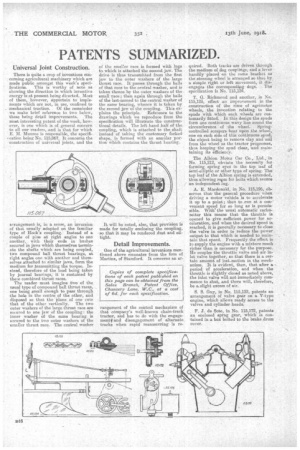PATENTS SUMMARIZED.
Page 22

If you've noticed an error in this article please click here to report it so we can fix it.
Universal joint Construction.
There is quite a crop of inventions concerning agricultural machinery which are made public amongst this week's speci fications. This is worthy of note as showing the direction in which inventive energy is at present being directed. Most of them, however, appertain to implements which are not, in use, confined to mechanical traction. . Of the remainder we make brief reference to two below, these being detail improvements. The moet interesting patent of the week, however, is one which is of general concern to all our readers, and is that for which E. M. Munrne is responsible, the specification being No. 115,067. It concerns the construction of universal joints, and the arrangement is, in a sense, an inversion of that usually adopted on the familiar type of Hook's coupling: Instead of a couple of pins at right angles to one another, with their ends in bushes secured in jaws which themselves terminate the shafts which are being coupled, two compound ball thrust bearings, at right angles one with another and themselves attached to similar jaws, form the medium for _transmitting the torque. Instead, therefore of the load being taken by journal bearings, it is sustained by these combined thrust races.
The reader must imagine two of the usual typo of compound ball thrust races, one being small enough to pass through the hole in the centre of the other, and disposed so that the Plane of one cute that of the other vertically. The two outer washers of the large thrust race are secured to one jaw of the coupling ; the inner washer of the same bearing is secured to the tsva outer washers of the smaller thrust race, The central washer of the smaller race is formed with lugs to which is attached the second jaw. The drive is thus transmitted from the first jaw to the outer washers of the large thrust race. It passes through the balls of that race to the central washer, and is taken thence by the outer washers of the small race; then again through the halls of the last-named to the central washer of the same bearing, whence it is taken by the second jaw of the coupling. This explains the principle. Reference to the drawings which we reproduce from the specification will illustrate the constructional details. The left hand half of the coupling, which is attached to the shaft instead of taking the .customary forked shape, is formed with an annular portion which contains the thrust bearing.
It will be noted, also, that provision is made for totally enclosing the coupling, • so that it may be rendered dust and oiltight.
Detail Improvements.
One of the agricultural inventions mentioned above emanates from the firm of Martins, of Stamford. It concerns an ar Copies of complete specifications of each patent published on this page can be obtained from the Sales Branch, Patent Office, Chancery Lane, W.C.; at a cost of 6d. for each specification.
rangement of the control mechanism of that company's well-known chain-track tractor, and has to do with the engagementtand disengagement of alternate tracks when rapid mariceuvring is re quired. Both tracks are driven through the medium of dog couplings; and a lever handily placed on the same bracket as the steering wheel is arranged so that by a simple right or left movement, it disengages the corresponding dogs. The specification is No. 115,124.
T. G. Richmond and another, in No. 115,125, effect an improvement in the construction of the rims of agrimotor wheels, the invention relating to the spuds with which such wheels are customarily fitted. In this design the spuds form one continuous wavy line round the circumference of the wheel. Springcontrolled scrapers bear upon the wheel, one on each side of this continuous spud, the object being to remove clay and soil from the wheel as the tractor progresses, thus keeping the spud clear, and maintaining its efficiency.
The .Albion Motor Car Co., Ltd., in No. 115,212, obviate the necessity for forming spring eyes in the top leaf of ierni-elliptic or other type of spring. The top leaf of the Albion spring is extended, thus allowing room for bolts which secure an independent lug.
A. E. Macdonald, in No. 115196, observes that the general procedure when driving a motor vehicle Is to accelerate it up to a point; then to run at a con-vented, speed for so long as is permissible. With' the usual automatic carburetter this Means that the throttle is opened to give sufficient power for acceleration, and when the desired speed is reached, it is generally necessary to close the valve in order to reduce the power output to that which is needed to maintain that speed. Frequently the effect is to supply the engine with a mixture much richer than is necessary for the purpose. He couples the throttle valve and air inlet valve together, so that there is a certain amount of lost-motion in the mechanism. It is evident, then, that after a period of acceleration, and when the throttle is slightly closed as noted above, the inlet valve will not, immediately commence to shut, and there will, therefore, ho a...slight excess of air.
S. S. Guy, in No, 115,132, patents an arrangement of valve gear on a V-type engine, which allows ready access to the valves and cylinder heads.
F. de Soto, in No. 115,172, patents an enclosed sprag gear, which is contained in a box bolted to the brake drum cover.






















